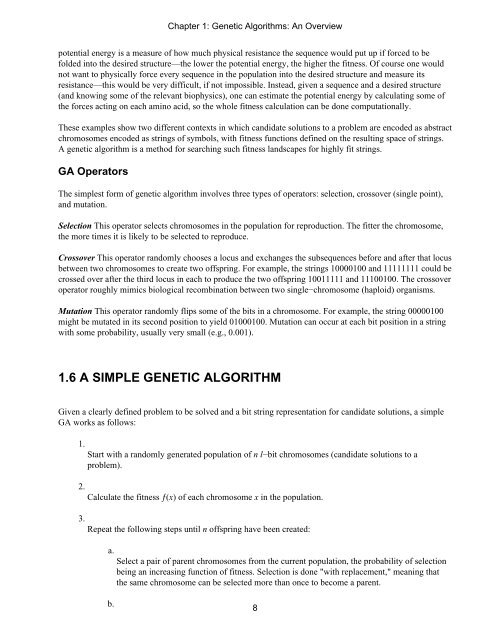An Introduction to Genetic Algorithms - Boente
An Introduction to Genetic Algorithms - Boente
An Introduction to Genetic Algorithms - Boente
Create successful ePaper yourself
Turn your PDF publications into a flip-book with our unique Google optimized e-Paper software.
potential energy is a measure of how much physical resistance the sequence would put up if forced <strong>to</strong> be<br />
folded in<strong>to</strong> the desired structure—the lower the potential energy, the higher the fitness. Of course one would<br />
not want <strong>to</strong> physically force every sequence in the population in<strong>to</strong> the desired structure and measure its<br />
resistance—this would be very difficult, if not impossible. Instead, given a sequence and a desired structure<br />
(and knowing some of the relevant biophysics), one can estimate the potential energy by calculating some of<br />
the forces acting on each amino acid, so the whole fitness calculation can be done computationally.<br />
These examples show two different contexts in which candidate solutions <strong>to</strong> a problem are encoded as abstract<br />
chromosomes encoded as strings of symbols, with fitness functions defined on the resulting space of strings.<br />
A genetic algorithm is a method for searching such fitness landscapes for highly fit strings.<br />
GA Opera<strong>to</strong>rs<br />
The simplest form of genetic algorithm involves three types of opera<strong>to</strong>rs: selection, crossover (single point),<br />
and mutation.<br />
Selection This opera<strong>to</strong>r selects chromosomes in the population for reproduction. The fitter the chromosome,<br />
the more times it is likely <strong>to</strong> be selected <strong>to</strong> reproduce.<br />
Crossover This opera<strong>to</strong>r randomly chooses a locus and exchanges the subsequences before and after that locus<br />
between two chromosomes <strong>to</strong> create two offspring. For example, the strings 10000100 and 11111111 could be<br />
crossed over after the third locus in each <strong>to</strong> produce the two offspring 10011111 and 11100100. The crossover<br />
opera<strong>to</strong>r roughly mimics biological recombination between two single−chromosome (haploid) organisms.<br />
Mutation This opera<strong>to</strong>r randomly flips some of the bits in a chromosome. For example, the string 00000100<br />
might be mutated in its second position <strong>to</strong> yield 01000100. Mutation can occur at each bit position in a string<br />
with some probability, usually very small (e.g., 0.001).<br />
1.6 A SIMPLE GENETIC ALGORITHM<br />
Given a clearly defined problem <strong>to</strong> be solved and a bit string representation for candidate solutions, a simple<br />
GA works as follows:<br />
1.<br />
Start with a randomly generated population of n l−bit chromosomes (candidate solutions <strong>to</strong> a<br />
problem).<br />
2.<br />
Calculate the fitness ƒ(x) of each chromosome x in the population.<br />
3.<br />
Repeat the following steps until n offspring have been created:<br />
a.<br />
b.<br />
Chapter 1: <strong>Genetic</strong> <strong>Algorithms</strong>: <strong>An</strong> Overview<br />
Select a pair of parent chromosomes from the current population, the probability of selection<br />
being an increasing function of fitness. Selection is done "with replacement," meaning that<br />
the same chromosome can be selected more than once <strong>to</strong> become a parent.<br />
8






